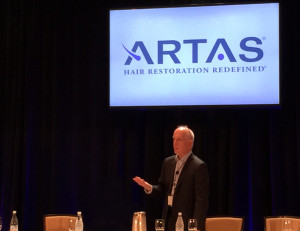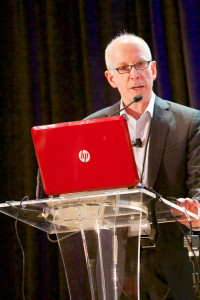Dr. Robert M. Bernstein introduced a new capability of the ARTAS® robotic system, “Follicular Unit Graft Selection,” at the ARTAS User Group Meeting on February 7th, 2015 in Newport Coast, CA. He presented the new technology and the preliminary results of a bilateral pilot study of the technique conducted at Bernstein Medical.
In robotic graft selection, the hair restoration surgeon programs the ARTAS robot to harvest follicular units based on the number of hairs in each unit. The robot first selects and then isolates larger follicular units of 2-hairs or more. If too few 1-hair units are extracted, the surgeon can program a second pass at extracting only the smallest grafts. As an alternative, the larger units can be divided into smaller ones using stereo-microscopic dissection. The goal is to both minimize wounding and harvest an adequate distribution of varying size follicular units to satisfy the surgeon’s, and ultimately the patient’s, aesthetic hair restoration needs. The new robotic graft selection system enables the robot to intelligently and efficiently harvest follicular units.
Results of the bilateral pilot study showed that the robot’s new graft selection capability was superior to random graft selection, the robot’s default setting, in the amount of hairs extracted per harvest attempt. Dr. Bernstein described how he was able to generate more transplantable grafts with fewer attempts at harvesting. By splitting larger follicular units into smaller grafts under stereo-microscopic dissection, he was able to produce additional grafts for use in the transplant without causing further wounding.
When the new computerized graft selection capability is coupled with dissection of larger units, the result is a substantial improvement over randomized graft selection. Read more about Robotic Graft Selection and the pilot study.
Dr. Bernstein also updated the meeting attendees on the robot’s recipient site creation technique that he introduced the prior year and some best practices in incorporating the ARTAS Hair Studio software into clinical practice.
Click here to read about Robotic Follicular Unit Graft Selection
Click here to read about Robotic Hair Transplants

ARTAS User Group Meeting 2015

Dr. Bernstein Presenting at ARTAS User Group Meeting 2015







